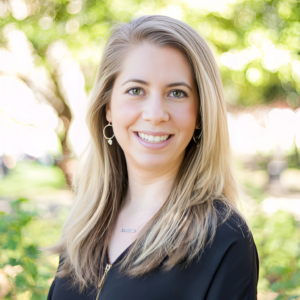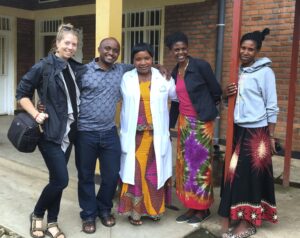Perspective from an American at the
World Health Organization
As the spread of information and disease accelerates, the role of effective communication in public health has never been more critical. At the heart of this challenge is a dedicated team of professionals at the World Health Organization (WHO), striving to ensure that factual, science-based information reaches the public. On that team is American Alyssa Palmquist, a Communications Officer based at WHO Headquarters in Geneva, Switzerland, whose efforts to deliver accurate health insights are equipping individuals and communities with the tools to self-direct their own health.
 “One of the core missions of our team at WHO is to share evidence-based information so that people can make the best decisions for themselves and their families. The most effective public health programs are about building agency and working with—not just directing,” Palmquist notes.
“One of the core missions of our team at WHO is to share evidence-based information so that people can make the best decisions for themselves and their families. The most effective public health programs are about building agency and working with—not just directing,” Palmquist notes.
Raised in Northfield, Minnesota, Palmquist earned her undergraduate degree from Tulane University (‘2007) and a master’s from the London School of Economics (‘2018). She started her career in global public health in the Middle East, focusing on women’s health, rehabilitation care and emergency preparedness. “I was working in a hospital in Qatar, where I observed firsthand how cultural norms and social structures impact health outcomes. That was what first got me interested in the intersection of health and social sciences.” Since then, she has also completed a Global Health Corps Fellowship which included a placement at Gardens for Health International—a non-profit focused on malnutrition prevention among smallholder farmers in Rwanda.
From media engagement to managing advocacy campaigns, Palmquist’s focus at WHO is ensuring that global health policies and data are accessible and understandable to both policymakers and the general public.
 “One of the biggest challenges in global health communication is translating technical content into compelling narratives,” she says. “We deal with highly complex topics—nutrition guidelines, pandemic response strategies, primary healthcare investments—but if we can’t communicate them and in a way that speaks to the values of target populations, then the behavior or policy change won’t happen.”
“One of the biggest challenges in global health communication is translating technical content into compelling narratives,” she says. “We deal with highly complex topics—nutrition guidelines, pandemic response strategies, primary healthcare investments—but if we can’t communicate them and in a way that speaks to the values of target populations, then the behavior or policy change won’t happen.”
“Part of my academic training was in anthropology,” she says. “The field teaches you to humble yourself and to recognize the wisdom in others rather than making assumptions. It’s also very much the approach that her team at WHO takes. We have to remember that behind every statistic is a human being. We’re always striving to bring that human-centered storytelling approach into our work with respect for the people we’re both learning from and serving.”
The Battle Against Misinformation
One of the most pressing issues in her role—indeed, across and beyond the global health field—is the rise of misinformation, particularly surrounding health crises. “We’re seeing an explosion of false narratives, particularly as social media platforms become echo chambers of like-minded users and as information is conveyed by those not trained in journalism,” she explains. “The challenge is that misinformation spreads faster than facts, and once people are entrenched in a belief system, it’s incredibly difficult to shift their perspective.”
That’s why WHO employs a dedicated team to monitor and respond to misinformation in real time. “We track falsehoods, analyze their reach and strategize our responses. But it’s not about just calling out inaccuracies, it’s endeavoring to understand the roots of their origin and ways we can constructively respond and engage.”
The Importance of WHO in a Fragmented World
In recent months, WHO has faced funding challenges, most notably from major donor countries like the United States. These challenges only strengthen Palmquist’s dedication to the organization. “People sometimes forget that WHO is more than an abstract institution—it’s made up of real people who are deeply committed to improving health outcomes and saving lives around the world. I see colleagues deploying to war zones, responding to humanitarian crises and working tirelessly every day. Even while so many are questioning the value of global health diplomacy right now, it’s important to remember that that hasn’t slowed our fight against the diseases that continue to make Americans sick.”
“People sometimes forget that WHO is more than an abstract institution—it’s made up of people who are deeply committed to improving health outcomes and saving lives around the world.”
She underscores that what’s needed now is support, not retreat. “The response to perceived inefficiencies should be investment and dialogue, not withdrawal. If something isn’t working, the solution is to provide more resources to improve the system, not to undermine the very mechanisms designed to protect and promote global health.”
Palmquist reflects on the scale of WHO’s reach by recalling a brief career stint in Boston, Massachusetts—a hub of U.S. healthcare, “WHO is covering everything from emergency response to nutrition, from cancer care to disability rights—and doing it for a population of 8 billion. And we’re working on a budget that’s less than many large hospitals like those in Boston and Chicago. Americans should realize just how remarkable that is.”
Personal Reflections on Public Health and Global Advocacy
Reflecting on her career, she sees herself as a bridge between technical health experts and the broader public. “My job is to make health policies and data more accessible, to ensure that people understand the science in a way that resonates with them personally.”
When asked what she wishes more Americans understood about WHO, she pauses. “I wish people knew that WHO isn’t a faceless bureaucracy. It’s a platform for dialogue, for collaboration, for information exchange and for healthy debate and discourse. It is made up of people who have dedicated their lives to health and humanitarian work. A world with WHO is better than a world without it.”
“WHO… is a platform for dialogue, for collaboration, for information exchange and for healthy debate and discourse. It is made up of real people who have dedicated their lives to health and humanitarian work. A world with WHO is better than a world without it.”
As Palmquist and her colleagues navigate the complexities of global health in the world’s largest public health organization, one thing remains clear: the world needs WHO and WHO needs support to continue its mission of ensuring health and wellbeing for all.
